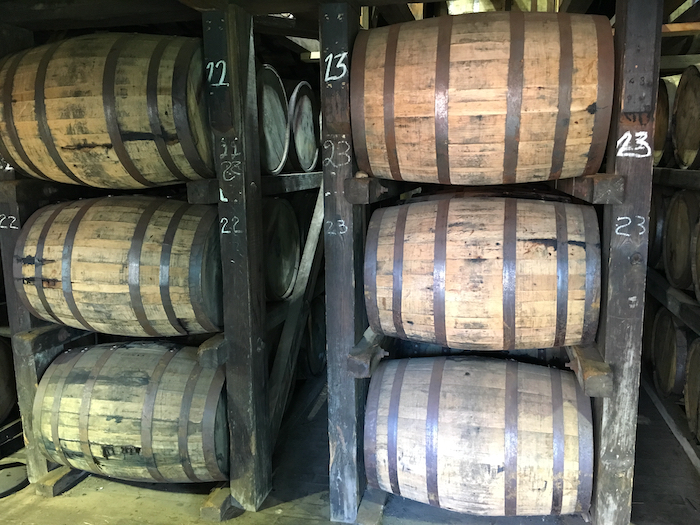Editor’s Note: This is Part 6 of a 9-part series about Baudoinia compniacensis, the whiskey fungus. Part 1 is here, Part 2 is here, Part 3 is here. Part 4 is here. Part 5 is here. It comes to us via a reprint from the original article at Chuck’s site.
Because the warehouses at Stitzel-Weller emptied out after production was moved to the new Bernheim Distillery, Baudoinia compniacensis, the whiskey fungus, wasn’t an issue there for most of the 1990s. Little was going on and it appeared the facility might be closed or sold. Then a growing Maker’s Mark began to rent warehouse space at Stitzel-Weller. Maker’s also revived the barrel dumping facility, rather than truck mature barrels back to Loretto.
After it sold Bernheim to Heaven Hill in 1999, Diageo began to buy distillate for its limited bourbon needs and began to refill the Stitzel-Weller warehouses. The warehouses at Bernheim were emptied and that whiskey was either sold or moved to Stitzel-Weller.
When Diageo acquired Bulleit after Seagram’s was broken up that whiskey, distilled at Four Roses, was aged at Stitzel-Weller too.

Because its Tennessee warehouses were full, Diageo brought barrels of bourbon distilled at George Dickel to Stitzel-Weller for aging, in violation of Tennessee law. After Diageo assured Tennessee officials that the whiskey stored in Kentucky was bourbon and would not be returned to Tennessee and sold as Tennessee whiskey, they were let off with a slap on the wrist.
Aging capacity at Stitzel-Weller is about 400,000 barrels. Although the stills had been silent since 1992, suddenly the place was buzzing again as the 21st century dawned.
Because zoning in Shively was always willy-nilly, there is little separation between industrial, commercial, and residential land use. What was farmland in 1933 is now densely developed, and there is a large neighborhood of modest, single-family homes just southwest of the Stitzel-Weller property.
As the barrel inventory there declined in the 80s and 90s, so inevitably did the amount of Baudoinia compniacensis growing on neighboring property. People forgot about it. Homes were sold, and new people moved in who had never scrubbed the black soot off their garage doors.
The 2011 Wired Magazine article about James Scott and his research at Hiram Walker gave Stitzel-Weller’s neighbors a name for their pain. One of them contacted William F. McMurry, a personal-injury lawyer in Louisville best known for his suits on behalf of victims of sex abuse by Catholic priests.
McMurry soon filed a class-action lawsuit against the three distilleries near Shively—Diageo, Brown-Forman, and Heaven Hill—claiming their negligence was responsible for the town’s property damage. McMurry argued that the fungus depressed the value of affected property to the tune of hundreds of thousands, maybe millions, of dollars.
The distillers answered, as they always have, that the fungus is naturally occurring, and their ethanol emissions are permitted under The Clean Air Act.
The 2012 LAPCD notice to Diageo cited odor complaints and Baudoinia growth. The district even added the following statement to its web site, though it was quickly removed.
“The presence of ethanol odors directly correlates with the rapid growth of Baudoinia compniacensis. While Baudoinia compniacensis is a naturally occurring mold, it is normally slow growing and eclipsed by other faster producing molds. However, when it is introduced to ethanol-rich environments, such as that surrounding a whiskey aging warehouse, it becomes uncharacteristically fast growing, resilient and adaptive to many environments. Thus, where whiskey aging warehouses exist, so will Baudoinia compniacensis.”
The warehouses at Stitzel-Weller are and always have been painted dark brown.
It is not unusual for whiskey to be aged somewhere other than where it was distilled. At a wide spot in the road near Bardstown called Coxs Creek, Four Roses has a maturation facility, but no distillery. Their distillery is in Lawrenceburg. Wild Turkey has rackhouses at the former Old Joe Distillery across the street from Four Roses Distillery, and also at the site of the former E. J. Curley Distillery in Jessamine County. All three facilities have been in use for decades. Beam, Heaven Hill, and Maker’s Mark also have stand-alone maturation facilities, typically at defunct distilleries.
Recently, producers have been building more stand-alones. Heaven Hill has a one on an isolated parcel near Coxs Creek, just east of U.S. Route 150 (Louisville Road).
Historically in communities where either distilleries or stand-alone maturation facilities are proposed, producers seek tax relief and other incentives from local governments, which usually consider whiskey production a good economic development investment. Sometimes opposition comes from neo-prohibitionists, but jobs and taxes usually carry the day. Since 2012, public concern about Baudoinia, whether warranted or not, has threatened the industry’s growth and perhaps the industry itself.
Although there is no evidence Baudoinia is a health threat, and a great deal of evidence it is not, these days it takes more than facts to keep people from claiming all sorts of dangers. Better to simply avoid the problem by keeping Baudoinia on company grounds, which is what producers are increasingly trying to do.
NEXT TIME: More nerdy legal stuff.








